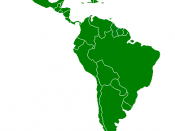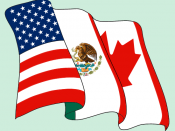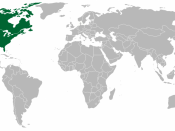The North American Free Trade Agreement (NAFTA) became effective in Canada, Mexico, and the United States on January 1, 1994. This agreement removed the tariffs and other trade barriers on goods produced and sold in North America. NAFTA forms the world's second largest free trade area. The largest free trade area is the European Economic Area, which also became effective in 1994. Talks began in late 1994 to expand NAFTA to include all Latin American nations. This will be called the Free Trade Area of the Americas (FTAA).
NAFTA is supposed to promote conditions of fair competition in the free trade area, and increase investment opportunities. It's also supposed to provide effective protection and enforcement of intellectual property rights.
The debate over NAFTA divides members of both the Democratic and Republican parties. Many fear that jobs are lost because the agreement makes it easy for U.S. production plants to move into Mexico.
In Mexico plants can take advantage of cheaper labor. Environmental groups are concerned that pollution and food safety controls are difficult to enforce. Under FTAA, workers in Mexico could find themselves competing against even more desperate workers in Haiti, Guatemala, or Brazil. Many think that NAFTA and FTAA put corporate profits over human costs, such as Americans losing good jobs and Mexicans working in polluted sweat shop conditions. Some believe that FTAA will increase entrepreneurship among Latin Americans, while others believe it will reduce it to even lower levels. Many U.S. industries without international ties believe the FTAA will make business conditions worse for them.
To reverse the economic slowdown, the United States is looking at Latin America for more external trade outlets. The FTAA would slow down competing European moves into Latin America. The U.S. hopes this agreement will fix some of our shaky military alliances...


